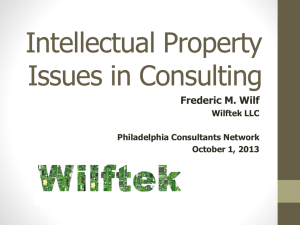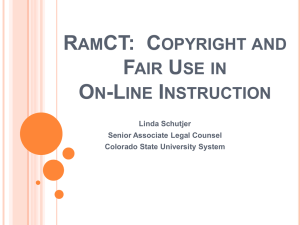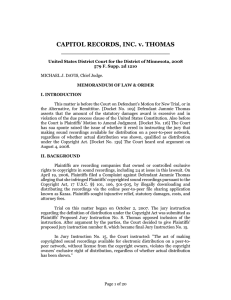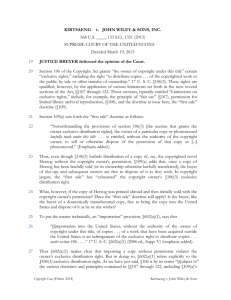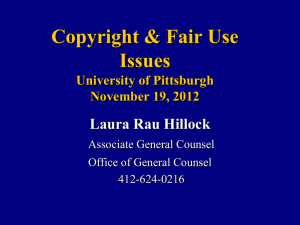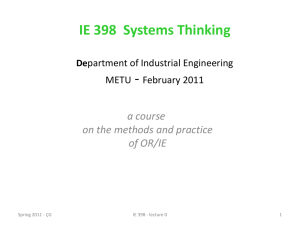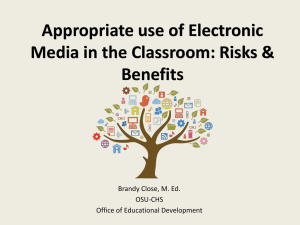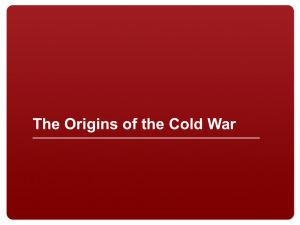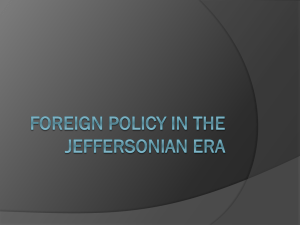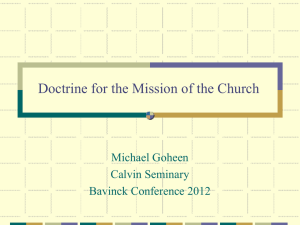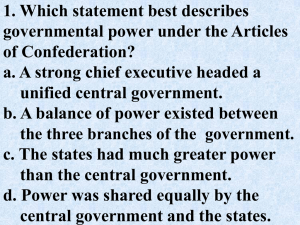Class Outline
advertisement
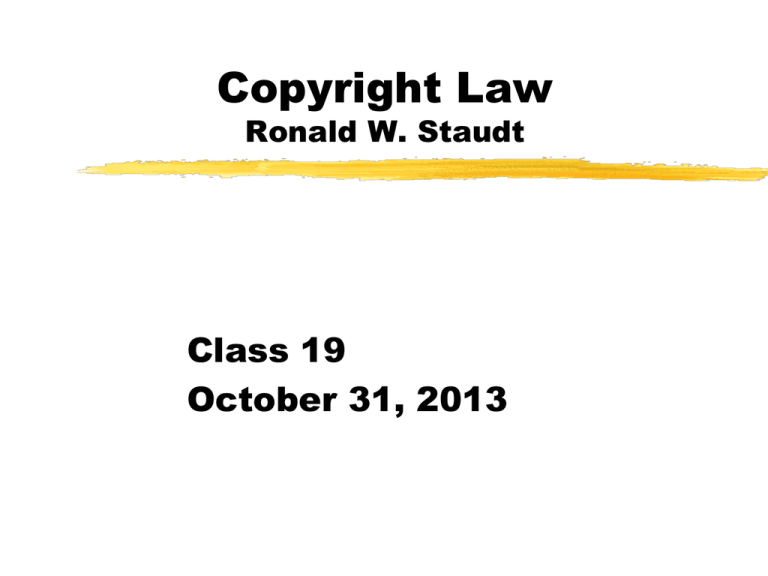
Copyright Law Ronald W. Staudt Class 19 October 31, 2013 Class Overview Quick Review of Derivative Right and VARA Distribution Right and First Sale Doctrine Sects. 106(3) and 109 Importation Right Sect 602 and Quality King and Kirtsaeng Derivative Works- Limitations Family Movie Act Sanifilms hypothetical, p. 668 Software Adaptations - Sect. 117 Moral Rights Gilliam v ABC work? Lanham Act Dastar and list of cases pp. 676-7 VARA Painting, drawing, print, sculpture, photograph NOT- movies, magazines, posters, databases, ads, books, diagrams, models, works for hire etc. A “work of visual art” is— (1) a painting, drawing, print, or sculpture, existing in a single copy, in a limited edition of 200 copies or fewer that are signed and consecutively numbered by the author, or, in the case of a sculpture, in multiple cast, carved, or fabricated sculptures of 200 or fewer that are consecutively numbered by the author and bear the signature or other identifying mark of the author; or (2) a still photographic image produced for exhibition purposes only, existing in a single copy that is signed by the author, or in a limited edition of 200 copies or fewer that are signed and consecutively numbered by the author. A work of visual art does not include— (A) (i) any poster, map, globe, chart, technical drawing, diagram, model, applied art, motion picture or other audiovisual work, book, magazine, newspaper, periodical, data base, electronic information service, electronic publication, or similar publication; (ii) any merchandising item or advertising, promotional, descriptive, covering, or packaging material or container; (iii) any portion or part of any item described in clause (i) or (ii); (B) any work made for hire; or (C) any work not subject to copyright protection under this title. Phillips v. Pembroke Real Estate Site-specific v. plop art, a park as a sculpture Public presentation State’s MAPA- broader and constitutional Eastport Park § 106. Exclusive rights in copyrighted works “Subject to sections 107 through 121, the owner of a copyright under this title has the exclusive rights to do and to authorize any of the following: (1) to reproduce the copyrighted work in copies or phonorecords; (2) to prepare derivative works based upon the copyrighted work; (3) to distribute copies or phonorecords of the copyrighted work to the public by sale or other transfer of ownership, or by rental, lease, or lending; “ § 109. Limitations on exclusive rights: Effect of transfer of particular copy or phonorecord (a) Notwithstanding the provisions of section 106(3), the owner of a particular copy or phonorecord lawfully made under this title, or any person authorized by such owner, is entitled, without the authority of the copyright owner, to sell or otherwise dispose of the possession of that copy or phonorecord. Distribution Right - 106(3) Digital technologies, p. 706 Playboy cases and RTC v. Netcom “Making available” & music sharing Electra Ent Group and London-Sire Records • “MediaSentry, posing as just another peer-to-peer user, can easily verify that copyrighted material has been made available for download from a certain IP address. Arguably, though, MediaSentry's own downloads are not themselves copyright infringements because it is acting as an agent of the copyright holder, and copyright holders cannot infringe their own rights. If that argument is accepted, MediaSentry's evidence cannot alone demonstrate an infringement.” London-Sire Records 542 F. Supp. 2d 153, 166 (DC Mass 2008) Electra Ent. V. Barker - publication and distribution “Having accepted that the definition of "distribute" is synonymous with the definition of "publication," however, liability under Section 106(3) requires that Plaintiffs -- to be faithful to the statute -affirmatively plead that Defendant made an offer to distribute, and that the offer to distribute was for the purpose of further distribution, public performance, or public display…. Thus, because Congress did not expressly equate the act of "offering to distribute . . . for the purposes of further distribution" to the act of "making available," Plaintiffs' allegations -- insofar as Plaintiffs wish to hold Defendant liable for acts of infringement other than actual downloading and/or distribution -- fail to state a claim.” 551 F. Supp. 2d 234 , 244-5 (DC SD NY 2008) London-Sire Records “Making available” & music sharing— “Plainly, "publication" and "distribution" are not identical. …In this context, that means that the defendants cannot be liable for violating the plaintiffs' distribution right unless a "distribution" actually occurred. …The Court can draw from the Complaint and the current record a reasonable inference in the plaintiffs' favor -- that where the defendant has completed all the necessary steps for a public distribution, a reasonable fact-finder may infer that the distribution actually took place. … Per the plaintiffs' pleadings, each individual Doe defendant connected to the peer-to-peer, network in such a way as to allow the public to make copies of the plaintiffs' copyrighted recordings…Through their investigator, the plaintiffs have produced evidence that the files were, in fact, available for download. They have also alleged that sound recordings are illegally copied on a large scale, supporting the inference that the defendants participated in the peer-to-peer network with the intent that other users could download from the defendants copies of the plaintiffs' copyrighted material….At least at this stage of the proceedings, that is enough. The plaintiffs have pled an actual distribution and provided some concrete evidence to support their allegation.”” 542 F. Supp. 2d 153, 169 (DC Mass 2008) Publication 17 U.S.C. 101 “Publication” is the distribution of copies or phonorecords of a work to the public by sale or other transfer of ownership, or by rental, lease, or lending. The offering to distribute copies or phonorecords to a group of persons for purposes of further distribution, public performance, or public display, constitutes publication. A public performance or display of a work does not of itself constitute publication. Making available Elektra Ent.- distribution = publication but P did not allege “offering to distribute..for the purposes of further distribution.” London-Sire Records– electronic file transfers fit within def. of distribution; Media Sentry proves feasibility of distribution, allegations and proof raise circumstantial inference of at least one download Capitol Records– WCT and WPPT are not self executing. ”The Court's examination of the use of the term "distribution" in other provisions of the Copyright Act, as well as the evolution of liability for offers to sell in the analogous Patent Act, lead to the conclusion that the plain meaning of the term "distribution" does not including making available and, instead, requires actual dissemination. “ First Sale Doctrine - what is a sale? Vernor v. Autodesk Facts re Autocad 14 and eBay Owner v. Licensee Wise Factors • Labeled a license, retain title, return/destruction of prints, no duplication, licensee to retain copies during agreement. MAI trio (117 essential step doctrine) Rule of this case: It’s a license if • Labeled a license • Significant transfer restrictions • Notable use restrictions Policy arguments Tiered pricing, increased sales, lower prices, less piracy D says restrains alienation, ignores economic reality, upsets ALA First Sale Doctrine – what is a sale? UMG Recordings v. Augusto Facts re promotional cds No fee, unsolicited, marked with label “promotional statement” Owner v. licensee for 109 purposes? • • • • • No prior arrangement Not numbered or identified or tracked No explicit acceptance by recipients of license status Vernor factors? Return of CD not required. Digital First Sale– ReDigi in supp. @ p. 77 109(b) – record rental exception Notwithstanding the provisions of subsection (a), unless authorized by the owners of copyright in the sound recording and in the musical works embodied therein, the owner of a particular phonorecord may not, for purposes of direct or indirect commercial advantage, dispose of, or authorize the disposal of, the possession of that phonorecord by rental, lease or lending. Brilliance Audio Soundrecordings of musical works or any soundrecording??? Are audio books covered? Context and legislative history – Congress intended to protect only sound recordings of musical works. § 602. Infringing importation of copies or phonorecords (a) Importation into the United States, without the authority of the owner of copyright under this title, of copies or phonorecords of a work that have been acquired outside the United States is an infringement of the exclusive right to distribute copies or phonorecords under section 106, actionable under section 501. § 501. Infringement of copyright (a) Anyone who violates any of the exclusive rights of the copyright owner as provided by sections 106 through 122 or of the author as provided in section 106A(a), or who imports copies or phonorecords into the United States in violation of section 602, is an infringer of the copyright or right of the author, as the case may be. § 109. Limitations on exclusive rights: Effect of transfer of particular copy or phonorecord (a) Notwithstanding the provisions of section 106(3), the owner of a particular copy or phonorecord lawfully made under this title, or any person authorized by such owner, is entitled, without the authority of the copyright owner, to sell or otherwise dispose of the possession of that copy or phonorecord. John Wiley v. Kirtsaeng Facts Friends and family buy textbooks in Thailand, ship them to D in California and he sells them on eBay. DC rejects sect 109 defense $600,000--$75,000/each of 8 titles “lawfully made under this title…” 109 v. 602 and Quality King Inportation Right & First Sale Quality King Distributors v. L’Anza Research The first sale doctrine is applicable to imported copiesfacts presented are round trip copies made in US and reimported. 602(a), importation right 106(3), distribution right 109(a) first sale doctrine Unanimous but J. Ginsburg round trip gloss John Wiley v. Kirtsaeng-- below Majority decision: “The first sale doctrine does not apply to copies manufactured outside the United States…” J. Murtha dissent Statute does not say manufactured in the United States , it says “lawfully made under this Title.” Policy reasons and economic justifications Quality King gloss?? John Wiley v. Kirtsaeng-majority Holding: reversed--first sale doctrine applies to copies of a copyrighted work lawfully made abroad. “Lawfully made under this title” 2nd, 9th , Wiley and SG—refers to geography Brief for US as Amicus Curiae 5 and 9th say it refers to copies made in US or made outside US and sold with permission in US D and majority say nongeographic interpretation is better fit with language, context, c/l history and practical consequences.. John Wiley v. Kirtsaeng Language_ geographic interpretation creates problems, simplicity and coherence favor D’s interpretation Context- 1909 language and 109(c) 109(e) 110(1) and introduction to 106 cannot support geographic interpretation c/l history in Bobbs-Merrill does not preclude d’s interpretation ALA, used book dealers, tech companies, consumer goods comps and museums.—list of horribles P says not likely and didn’t follow Scorpio Here, we are not sanguine, law has been unsettled, 9th circuit gloss (which cannot be located in the statute) etc Downstream control over authorized imports (no first sale applicable) John Wiley v. Kirtsaeng Quality King dicta about author giving US and British distribution rights to two different publishers: only the US edition would be “lawfully made under this title…”—dicta and wrong. Market segmentation now in trouble??? 109 undermines domestic segmentation Anti trust law disfavors segmentation If Congress wants this interest favored, needs to speak more clearly Perpetual downstream control worse than lack of market segmentation Quality King concession that it is unlikely Congress would write into the law an incentive for oversees manufacuturing John Wiley v. Kirtsaeng Kegan and Alito- if there is a problem now it was caused by Quality King which imposed 109 limits on 602. If Quality King were reversed, we would not be faced with the choice between perpetual downstream control v. destruction of market segmentation. Lawful owners of copies made abroad could resell but not import. John Wiley v. Kirtsaeng Dissent by Ginsburg, Kennedy and Scalia (interesting alliance?) Quality King dicta better result. Title 17 has no extraterritorial application Text exp. Word “under” favors P, consistent with 602(a)(3) c exceptions History supports P International exhaustion?—US takes national exhaustion position in trade talks. Antitrust, horribles- where are they?
